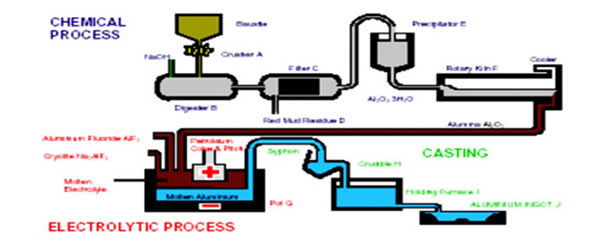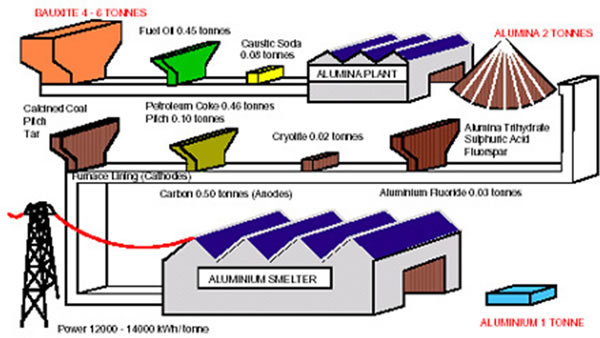Know More about
Aluminium
Rare
and expensive a century ago, aluminium has since been identified as the most common
metal on earth, forming about eight percent of the earth crust. It is the third
most plentiful element known to man. Only oxygen and silicon (sand) exist in
greater quantities.
The scientists who preceded Héroult and Hall had been concerned entirely with a chemical process for producing the metal. Héroult and Hall introduced a new concept. They believed that the answer to economic production lay in an electrolytic method. They had the idea that if some substance could be found which would conduct electricity and in which aluminium oxide (Al2O3), known as alumina, would dissolve, then an electric current passed through the solution could deposit the aluminium as metal.
There are some solutions which will dissolve aluminium, but these are aqueous (water) solutions. Unfortunately, water cannot be used because it would break down instead of the alumina when an electrical current is passed through it. There followed a long and intense search for a non-aqueous solution that would dissolve alumina. Both Hall and Héroult discovered that molten cryolite was the answer.
Cryolite is a white translucent, sodium aluminium fluoride material component found in its natural state only in Greenland. Most of the cryolite used in aluminium production today is synthetically produced. Held at 1030°C, the molten cryolite dissolves up to 20% of alumina readily. The electrolytic cell holding the molten cryolite is a tank lined with carbon which serves as one electrode. Large carbon blocks inserted from the top of the bath act as the anode, or other electrode, and a heavy electrical current is passed between these two sets of electrodes through the solution. This current breaks down the alumina into aluminium and oxygen. The molten metallic aluminium collects at the bottom of the cell and is drained off every few days as sufficient metal accumulates. The oxygen combines with the carbon at the anodes and is given off as carbon dioxide gas. This became the first industrially applied method of making the metal aluminium from alumina, and is the one still in use today.

The immediate effect of the discovery of this process was to send the price of aluminium tumbling from $18 to $4.50 per kg, the first step in a downward course which has today established the selling price in terms of under two dollars per kg. But the discoveries bringing about low-cost production did not lead directly to the widespread use of aluminium. Manufacturers, schooled in the traditions and skilled in the use of metals such as iron, copper and steel, were slow to capitalize on the potential benefits of this metal although it was known to be light, strong and highly resistant to corrosion. Alumina is produced in a totally separate first stage process from Bauxite ore. This (Bayer) chemical process starts by immersing crushed bauxite into a caustic soda solution which dissolves the alumina to form sodium aluminate liquor. After filtering, the impurities are left behind as a red mud and the liquid is treated to precipitate the aluminium content out of the solution which is now in the form of aluminium hydroxide. This material is then separated from the liquor and changed to alumina, which resembles course granulated sugar, by heating in kilns at 1000°C.
Approximately 4 kilogram of bauxite is required to produce 2 kilogram of alumina. Although the process of manufacturing aluminium has changed little since the Héroult- Hall discovery the efficiency and environmental aspects have improved over the years. In today modern plants 12 to 14 kilowatt hours of electricity and 2 kilogrammes of alumina would be required to produce 1 kilogramme of metal. A more detailed breakdown of the raw materials to produce a tonne of metal is shown in Figure.



